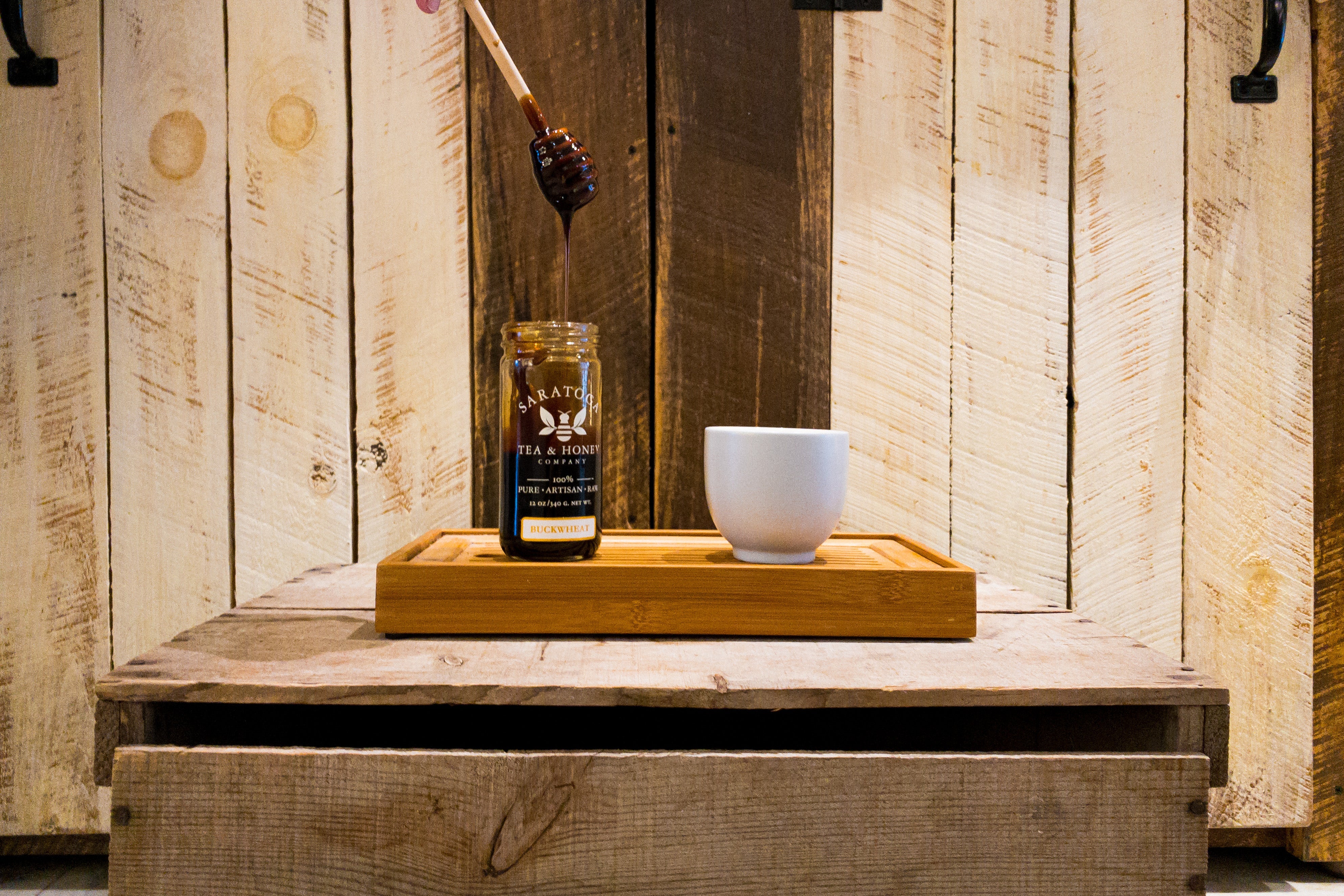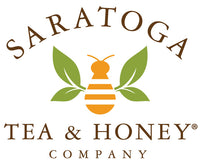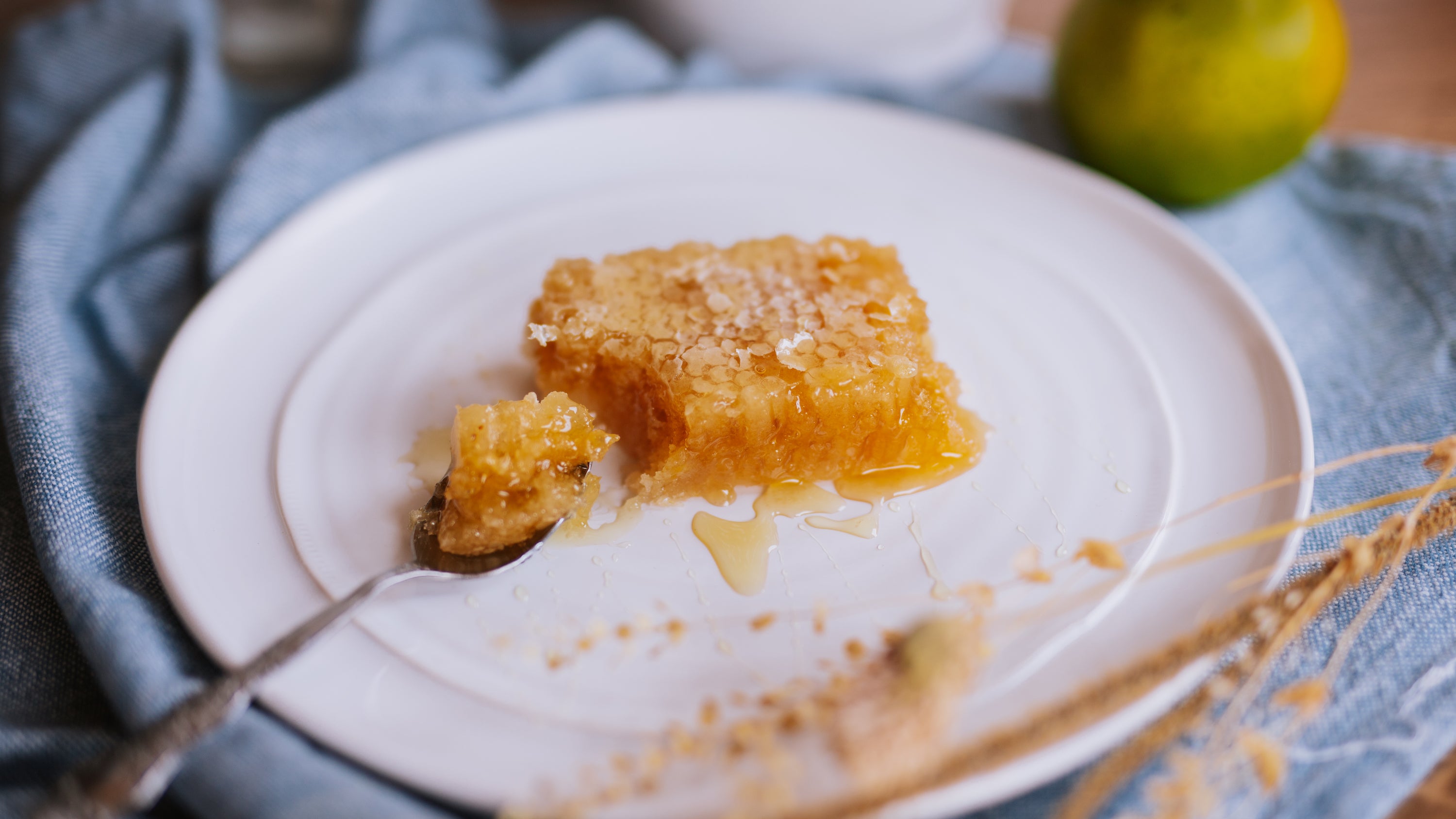
Look closely inside any bee hive, and you will find an army of bees working in unison to create a sweet, sweet thing: honey. Not only is honey a wonderful natural sweetener, there are also some amazing health benefits that can be gained from incorporating raw honey into your diet. While all honeys contain healthy minerals and antioxidants, these health benefits can be found in higher concentrations in certain dark honeys. Similarly to other goods, such as maple syrup, honey is classified by the USDA into different categories depending on color. These categories are: water white, extra white, white, extra light amber, light amber, amber and dark amber. The classification of honey color is measured using a tool called the Pfund Grader. A variety of factors contribute to the vast color variety of honeys available throughout the world.
What is Dark Honey?
In order to produce a certain type of honey, beekeepers position their beehives in areas that contain a high concentration of plants the bees are intended to pollinate. While there is no saying exactly where a bee goes, and exactly what it chooses to gather nectar and pollen from, they generally remain within about a four mile radius when pollinating. This is how we get monofloral honey, or honey that contains over a certain percent sample of represented pollen. Certain plants that the bees pollinate have darker pollen and nectar, and contain different minerals in higher amounts that contribute to the darker color of the honey. Beekeepers will find the honey they harvest will be different colors in different seasons, based on what plants are in bloom and when. Honey that also remains inside of honeycomb for longer periods of time than other honeys can become darker in color, due to some oxidation. These combinations of factors contribute to the wide spectrum of honey color gradient that can be found in the world.
Is Dark Honey Healthier?
Raw honey in general has lots of health benefits. Raw honey is naturally antimicrobial, and contains minerals, enzymes, and antioxidants. Studies have also shown that some raw honey contains Lactobacillus probiotics (Shin H.S, 2005). However, darker honeys have been shown to contain higher amounts of these antioxidants, minerals, and enzymes. Lighter honeys have been recorded to contain about a 0.04% mineral content, when some darker honeys have been recorded to contain closer to 0.20% (Solayman, Md, 2015). Research seems to conclude that the minerals and antioxidants found in honey have a positive correlation, meaning darker honey has higher amounts of both. Minerals found in honey come from the environment and soil, and then into the plants that bees pollinate. Trace minerals are important to human health, and are needed for body function. Antioxidants are important to our health because they help our bodies fight free radicals, which can cause harm if they become too prevalent in our bodies. Antioxidants prevalent in higher concentrations in darker honeys include flavonoids, phenolic acids, and enzymes. Antioxidant and mineral content found in honey can be tested by measuring the electrical conductivity of a honey sample. Pretty neat!
Our Dark Honeys

Sourwood
Sourwood honey is on the lighter side of our darker honeys, falling in the light amber category. This domestic honey comes from sourwood trees, growing in the Southern Appalachian Mountains and into Georgia. These trees bloom only for about three weeks, and produce high amounts of nectar, making them a highly desirable stop to honeybees! The pollen from the sourwood trees can also be an allergen to some, and it is said that regular consumption of raw sourwood honey can help folks ease these allergy symptoms. This honey has tasting notes of caramel, butter, and a touch of a spice or star anise in the aftertaste. A popular drink among farmers in the Appalachian region is the “switchel”, also known as the haymaker’s punch. This usually consists of a mix of ginger, apple cider vinegar, seltzer water, and sourwood honey. It can help ease stomach pain and be a natural refreshing source of electrolytes on a hot day, offering just some of benefits of honey and apple cider vinegar when working together. You can also use sourwood honey in gingerbread recipes, biscuits, as a pork glaze, or in black tea.
Palmetto
The next darkest honey in our collection is Palmetto, falling into the amber category. This honey comes from saw palmetto trees. These slow-growing trees grow in the south, including Florida, where our Palmetto honey originates. Bees do not pollinate them until they are mature enough to produce enough nectar, or closer to 100 years old! This honey is harder to find and a beautiful result of nature working together over time. It has been said to rival the health benefits of manuka honey, since it is rich in similar enzymes, antioxidants, and antimicrobial compounds. Palmetto honey has a rich, sweet, and smoky flavor with light citrus and wood notes. We think it tastes almost like a toasted marshmallow, and recommend trying it with a smokier tea, like Lapsang Souchong or Russian Caravan.
Black Forest
Getting into the darker honey category of dark amber, we have our Spanish Black Forest honey. This unique honey does not come from the usual blossom nectar and pollen of a plant alone, but also from the help of some of our little friends, the aphids! Aphids and other plant sucking insects feed on trees, leaves, and sap to get their required nutrients. They need to work their way through lots of plant matter, which contains water, sugar, and amino acids, in order to get the right amount to keep them energized. The waste product that they don’t need is what we know as honeydew. They expel this sweet substance onto nearby leaves and branches in large quantities, where it is then utilized by other insects, like honey bees and ants. Because the honeydew is plant matter processed through the digestive system of the aphid, combined with some other pollen and nectar sources, and then processed by honeybees, it contains extra minerals, enzymes, and antioxidants than many other honeys. Honeydew honey is also said to be higher in certain oligosaccharides, or prebiotics that can have a beneficial effect on gut bacteria and digestion. We recommend trying honeydew honeys like our Spanish Black Forest over toast with eggs sprinkled with pepper and turmeric, or in rich earthy aged teas.
Buckwheat
Buckwheat is our darkest honey, falling into the dark amber category. Buckwheat flowers grow in a variety of climates and can be found in different parts of the world, and ours comes from Washington state. A University of Illinois At Urbana-Champaign study showed that honey made from the pollen and nectar of buckwheat flowers can have 20 times the antioxidant value of lighter honeys, such as sage honey. It is also said to be a natural intestinal health aid, as studies have shown it supports the growth of the good Bifidobacteria and restricts the growth of bad gut bacteria (Jiang et al, 2020). This honey is earthy, rich, and comparable to molasses. It pairs wonderfully with sharp cheeses, as a syrup substitute over breakfast, or as a marinade for barbecue. It also pairs nicely with rooibos based teas, like Saratoga Red Chai.
Overall, raw honey is an excellent and proven healthful alternative to other sweeteners. Buzz on over to our monofloral page to explore these dark honeys for yourself, and try them in your everyday routine, or in exciting new recipes.
Resources and further reading:
Carbohydrate composition of honey from different floral sources and their influence on growth of selected intestinal bacteria: An in vitro comparison. Shin H.S; Ustunol Z. Food Res Int 38:721-728, 2005.
Honey with High Levels of Antioxidants Can Provide Protection to Healthy Human Subjects. Derek D. Schramm; Malina Karim; Heather R. Schrader; Roberta R. Holt; Marcia Cardetti; and Carl L. Keen Departments of Nutrition and Internal Medicine at the University of California. J. Agric. Food Chem., 2003, 51 (6), pp 1732–1735
Jiang L;Xie M;Chen G;Qiao J;Zhang H;Zeng X; “Phenolics and Carbohydrates in Buckwheat Honey Regulate the Human Intestinal Microbiota.” Evidence-Based Complementary and Alternative Medicine : ECAM, U.S. National Library of Medicine,
Solayman, Md., et al. “Physicochemical Properties, Minerals, Trace Elements, and Heavy Metals in Honey of Different Origins: A Comprehensive Review.” Comprehensive Reviews in Food Science and Food Safety, vol. 15, no. 1, 2015, pp. 219–233.,
Terrab, Anass, et al. “Mineral Content and Electrical Conductivity of the Honeys Produced in Northwest Morocco and Their Contribution to the Characterisation of Unifloral Honeys.” Journal of the Science of Food and Agriculture, vol. 83, no. 7, 2003, pp. 637–643.,
University Of Illinois At Urbana-Champaign. (1998, July 8). Dark Honey Has More Illness-Fighting Agents Than Light Honey. ScienceDaily. Retrieved March 21, 2021



